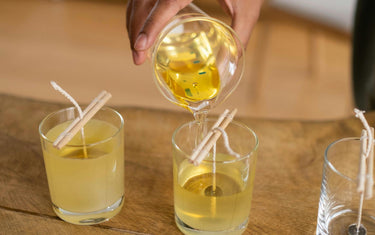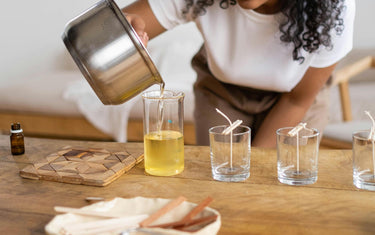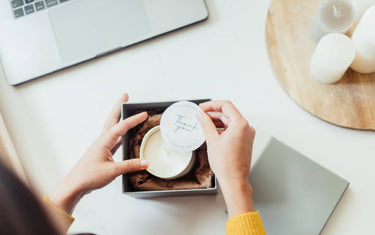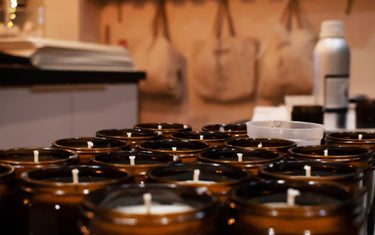8 min read / 12 August 2024 / yasmin sharp
7. Advanced Candle Techniques and Innovations
Discover advanced techniques and sustainable practices for candle making with Nikura. Learn about embeds, layering, eco-friendly materials, and more.
Share this post
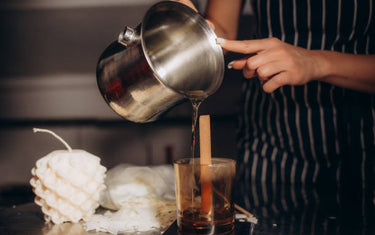
Candle making is continually evolving with new techniques and innovations.
No matter whether you’re a seasoned pro or complete beginner, there is always something new and exciting to learn!
At Nikura, we're passionate about helping our customers keep up to date with the latest trends in the industry.
In this blog, we'll explore some advanced candle making techniques and innovations, including decorative techniques and sustainable practices for your candles.

Decorative Techniques
Candle Embeds and Additives
Embeds and additives are both great decorative candle making techniques, and can help you add a unique touch to your products. Decorations for candles are also a great chance to get creative during the candle making process!
What Are Embeds and Additives?
Embeds
Objects such as flowers, crystals, or small shapes made of wax that are placed inside or on top of the candle. These elements can be purely decorative or hold personal significance, such as a favourite flower or a meaningful symbol.
Additives
Additives are substances added to the wax to alter its appearance or performance, such as dyes, glitter, or scent boosters. Additives can enhance the candle's aesthetic appeal or its burning properties, allowing for a more customised product.
How to Use Them
Safety First
Safety is paramount when making candles, and you should always ensure that all embeds and additives are non-toxic and heat-resistant. It's crucial to test the materials you plan to use to ensure they do not pose any safety hazards when heated.
Creative Placement
Another way to use them is to strategically place embeds in clear wax or within layers. This can help create a floating effect or a buried treasure look.
Additive Tips
Mix additives evenly to avoid clumping and ensure a smooth finish. Proper mixing techniques can prevent issues such as uneven burning or clogged wicks, so you’ll get a high-quality final product.
Popular Trends
- Botanical Candles: Dried flowers and herbs are popular choices for creating natural, beautiful candles. They add a touch of nature and can also provide subtle, natural scents that enhance the overall experience.
- Crystal-Infused Candles: Incorporating semi-precious stones adds a touch of elegance and mystique. These candles are often used for meditation and relaxation purposes, providing both aesthetic and spiritual benefits.
- Scented Candles: Unique fragrance blends create a memorable sensory experience. Combining different scents, such as our Vanilla Fragrance Oil and Peppermint Essential Oil, can produce inviting aromas and an enjoyable product.

Layering and Marbling
Layering and marbling candles are both useful decorative techniques you can use as part of your candle making process. If you want to create a visually appealing product range, then these techniques are worth experimenting with.
How to Make Layered Candles
There are three different ways you can make layered candles. We’ll delve a little deeper into each of these methods below.
- Basic Layering: Pour different coloured waxes in layers to create a striped effect. You can use a variety of different colours to create the candle of your dreams.
- Gradient Layering: Gradually change the colour intensity with each layer for an ombre effect. This technique requires careful control of dye concentration and pouring methods to achieve a seamless transition.
- Fragrance Layering: This involves adding different scents to each layer to give the customer a multi-sensory experience. If you want a candle that evolves in fragrance as it burns down, then you’ll want to try out fragrance layering.
How to Make Marble Candles
Thankfully, making marble candles is fairly straightforward once you know how. Marble candles feature intricate, swirling patterns. This effect is achieved by blending different coloured waxes together to help mimic the appearance of natural marble stone.
Marbling candles is a great technique to utilise if you want to create a visually appealing product. Here’s how you can achieve such an effect:
- Swirling Colours: Use a stick or skewer to swirl different coloured waxes together before they set. This creates intricate patterns that can mimic natural stone or abstract art.
- Using Moulds: Pour multiple colours into a mould and swirl them around for a marbled look. Moulds are also useful if you want to create interesting shapes and textures for your finished candle.
Tips for Success
Learning new techniques when it comes to candle making will take time and practice. However, there are a few tips you can try to make the process easier when experimenting with new techniques.
First, you should note that maintaining consistent temperatures will help prevent your candles from cracking and ensure smooth transitions between layers.
Temperature fluctuations can affect the adhesion of layers and the appearance of marbling. For this reason, it’s essential that you monitor and control the heat carefully.
Likewise, don't be afraid to experiment with different colour combinations and techniques to find what works best for you.
Keeping a detailed log of your experiments can help you refine your methods and achieve better results over time.

Bubble Candles
Bubble candles have a unique, bubble-like texture, and are often created using specialised silicone moulds. These candles are a great way to add a playful twist to your product line.
While making bubble candles may feel daunting at first, breaking it down into simple, manageable steps can make the process much easier.
How to Make Bubble Candles
Choosing Moulds
Select bubble moulds made of silicone for easy removal. These moulds are very flexible and will help delicate bubble shapes remain intact.
Pouring Wax
The process begins with melting the wax using a double boiler. This method is safe and effective and will help to stop the wax from overheating.
Once it melts you can add fragrance oils and dye to give your products a scent and colour.
Pour the wax slowly to ensure it fills all the bubble cavities evenly. Slow pouring minimises air bubbles and ensures a smooth finish.
Cooling Time
Allow the candle to cool completely before removing it from the mould to maintain its shape.
Rushing this process can result in deformations or cracks, compromising the candle's appearance and durability.
Design Variations
- Colour Variations: Use different colours for each bubble layer or a single colour for a uniform look. You can also experiment with colour gradients within the bubbles for a visually dynamic effect.
- Scented Options: To add a unique touch, mix fragrances into the wax for scented bubble candles.

Sustainable Practices for Candle Making Techniques
Eco-Friendly Materials
When you’re making eco-friendly candles, working with eco-friendly materials all the way from production to packaging is crucial. After all, you want to create candles that are kind to the environment. Sustainable candle making not only reduces your carbon footprint but also promotes a healthier planet for future generations.
Natural Waxes
- Soy Wax: This wax is biodegradable and burns much cleaner than paraffin. It’s a popular choice for eco-conscious candle makers as its environmental impact isn't as significant.
- Beeswax: Beeswax is natural and non-toxic, produces a long-lasting burn, and also emits a natural honey scent.
- Coconut Wax: Renewable and has a slow, even burn. Coconut wax has a strong scent throw and creamy texture, so it's ideal if you want to make high-end candles.
Natural Fragrances and Dyes
- Essential Oils: These offer natural scents without synthetic chemicals. Essential oils can provide therapeutic benefits and come available in various scents, from calming lavender essential oil to refreshing citrus.
- Natural Dyes: Plant-based dyes offer vibrant colours without harmful additives. These dyes are derived from roots, leaves, and flowers, offering a safe and eco-friendly way to colour your candles.

Benefits of Eco-Friendly Materials
While being an eco-friendly company helps to boost your brand image, it also comes with many other real-world benefits. For example:
- Reduced Environmental Impact: Using sustainable materials helps protect the planet. It reduces reliance on non-renewable resources and minimises waste, contributing to a healthier ecosystem.
- Healthier Indoor Air Quality: Natural ingredients contribute to a healthier home environment. They produce fewer pollutants and are less likely to cause allergies or respiratory issues, making them a safer choice for indoor use.
- Appeal to Eco-Conscious Consumers: Many consumers prefer environmentally friendly products. This may help boost brand appeal and customer loyalty, as people are more likely to support businesses prioritising sustainability.
Sustainable Packaging
It’s not just about making eco-friendly candles. By using eco-friendly packaging for candles, you’ll reduce your brand's carbon footprint and appeal to eco-conscious customers.
Packaging Options
Packaging and shipping your candles is important. Thankfully, there are plenty of sustainable ways to do so.
- Recyclable Materials: Use boxes and labels made from recycled paper. Recycled materials help reduce waste and the demand for new raw materials, supporting a circular economy.
- Biodegradable Packaging: Choose biodegradable options for wrapping and packing materials. Because these materials break down more easily in the environment, they help to reduce landfill waste and pollution.
- Reusable Containers: Encourage customers to reuse candle jars and tins. Offering discounts or incentives for returns can promote this practice, reducing waste and fostering customer engagement.
Tips for Implementation
- Sourcing: Ideally, you should try to partner with suppliers who prioritise sustainability. Vet your suppliers to ensure they adhere to eco-friendly practices to show your commitment to the environment.
- Branding: Highlight your commitment to sustainability in your marketing materials. Transparency about your practices can build customer trust, and may even act as a USP for your brand.
- Customer Education: Let customers know how they can recycle or repurpose your packaging. Providing instructions or creative ideas can increase participation and foster community around your brand.

Benefits of Using Eco-Friendly Packaging for Candles
Builds Brand Image and Loyalty
Demonstrating a commitment to sustainability can portray a positive brand image, which may help attract customers.
Reduces Waste and Environmental Impact
Sustainable practices will help reduce the overall ecological footprint. If you care about preserving natural resources and mitigating climate change, then this is a huge benefit.
Meets Growing Consumer Demand for Sustainable Products
The demand for eco-friendly products is growing. By offering sustainable candle products, you can attract and retain these customers, which in turn will have a positive impact on the long-term success of your business.

In Summary
After reading this guide, you should have a much better understanding of advanced candle making techniques and how you can apply them to your own brand.
Implementing sustainable practices can be advantageous throughout every step of the production process.
If you’re a small or large business owner looking for a discount on candle making supplies, sign up for a Nikura wholesale account. You’ll get access to exclusive discounts that can help save your business money.


